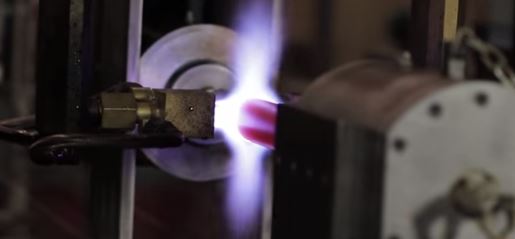Flame Hardening Methods and Applications

As we continue to discuss heat treating design issues, let’s do an overview of four distinct flame hardening methods we use at FTSI to meet various client needs.
These flame hardening methods are:
• Stationary
• Progressive
• Spinning
• Combination
Each flame hardening method lends itself better to certain applications over others – and it’s helpful during the design phase if you know which method might work better in your own application. Future blogs will go more into the design details of each method, but here let’s just give a broadbrush overview as a means of introduction to each method.
Stationary flame hardening heats up one certain area while the quench either comes to the heated area or the whole part goes down into the quench. See the Stationary Method Video . In a future blog I’ll go into detail about what’s exactly happening in the videos. Stationary flame hardening works best for really large parts that are hard to maneuver or when the area needing hardening is shaped irregularly. Quite often the parts used in this method are castings since they typically have rounded edges or irregular shapes. Stationary flame hardening machines typically require only one torch which can keep the costs of the solution lower than those with multiple torches.
Progressive flame hardening uses both heat and quench at the same time from the flame head. The flame head either moves across the area or the part moves underneath the flame head for heat and quench. See Progressive Method Video. Parts best suited for progressive flame hardening include steel bars and rails, or anything with significant length, such as ways on a lathe bed or a vice bed. You can also do wheels that turn in front of the flame head with a specific start and stop point. Contrast that to a rope drum that needs a spiral hardness pattern, so the whole drum is repeatedly turned until the spiral pattern is complete. This solution also typically requires only one torch which keeps the costs lower than multiple-torch solutions.
The spinning method uses a chuck to position parts in front of flame heads, spins them, and then drops them into a quench. Spinning machines are best for flame hardening round parts like crane wheels and gears, up to about 1500 pounds and 60” in diameter. See Spin Hardening Method Video. Parts larger than this will usually require progressive hardening. Spinning machines are typically more expensive because they use more torches to achieve the necessary control over the hardening area and pattern. More torches increase the price.
Finally, the combination flame hardening method combines the spinning and progressive methods. With this method the machine spins the part in front of the flame heads while they produce both flame and water for quench. The heat and the quench move down the part while it spins. Combination machines are best used for parts like shafts and cylindrical rolls. See Combined Hardening Method Video. Because of the spinning action they require more than one torch so they are more expensive than using progressive flame hardening on its own.
I hope this overview of flame hardening methods has helped you understand the inherent flexibility that comes with flame hardening solutions for heat treating. Depending on material and mass, we can design a solution that delivers the heat and the cool where it’s needed. Send us drawings of your parts and your heat treat specs. Let’s talk about the best and most cost-effective method for your heat treating needs. Email me at mark@flametreatingsystems.com or call 919-956-5208. Happy heat treating!
B16: We would like to know your opinion.






